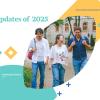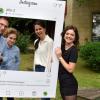Does dancing have a beneficial effect on the fetus?
2020
Feb
25
Beatrix Bánkyné Perjés has been the motor of the University of Pécs’s very own Dancing University from the get-go. Besides organizing, dancing, and teaching this delicate woman also studies at the UP FHS Doctoral School of Health Sciences; her supervisor is prof. dr. József Bódis. During the International Association for Dance Medicine and Science’s 29th international conference in Montreal (24th -27th of October) she won the Marjorie Moore Student Poster Award, which is a great accomplishment that comes with monetary benefits.
How can we measure the effects of dancing on the fetus?
My exact research topic is the effect of dancing on the mother’s physical, mental, psychological, and social wellbeing, on the fetus’ development and on the mode of delivery. At the conference I presented my findings only about fetal development. I analyzed 13 mothers-to-be who attended my dance classes twice a week. Then I visited the babies at the age of five weeks to assess their abilities. There is a test that lets researchers determine a baby’s performance compared with norms of children of the same age. Using this method I measured the cognitive functions, fine- and gross motor skills, receptive and expressive communication and the social-emotional situation. Put it simply I looked at for example how long they can keep their heads up, to what extent they can track moving objects, and how they react to sounds.
Those babies, whose mothers had danced regularly during the pregnancy, were more developed.
I think you already suspected so.
Yes, this was my hypothesis; that movements coordinated to music provide additional stimuli for the fetuses and it helps their nervous system develop faster and further.
During the dance sessions we monitored the babies’ heart rates. It was of the utmost importance not to let it rise to dangerous levels, but it was obvious that every baby’s heart rate rose. They moved around more in the uterus and they received more stimuli from their mothers’ elevated mood and movements to the music.
How did you come up with the idea to research the effects of dancing on the fetus?
As a mother and dancer I thought a lot about how I could combine these two roles. And I wondered how I could introduce and endear dancing to a child as early as possible and the answer was during pregnancy.
In 2016, thanks to an Erasmus Staff Mobility scholarship, I had the opportunity to attend an international dance-related forum in Amsterdam. Since then I became a member of multiple international groups concerned with dance’s effects on health. Incidentally, back then when they showcased the posters everybody was awestruck because even though a lot of studies were conducted on early development there were none published about the effects of dancing before.
But let me mention my research partners: dr. Gábor Mátrai, dr. Bernadett Nagy, Daniella Erdei, Viktória Prémusz.
What dances did you perform with the young mothers?
We practiced five different dance-genres, because I wanted to showcase different aspects of femininity.
There were choreographed steps but the mothers improvised some as well. At the end of the lessons we always danced to the same song, the choreography of which concentrated on the babies. The mothers had to dance as if they were holding their babies in their arms. Interesting thing is that when I visited the baby who was born first in the row her mother told me that this song reliably sooths the baby. On the other hand there was a mother, who hadn’t listened to the song since her last sessions, but when I suggested it to her as a way to sooth her agitated baby, her child’s eyes widened and he calmed down, then when the song finished the baby started crying again so we replayed the song and he fell asleep. I tried it with each and every baby and they all calmed down and seemed to remember the song. By the way it was the Hungarian adaptation of You’ll be in my heart from Tarzan (Szívem vigyáz rád) performed by Bereczki and Szinetár. I thought that this song’s lyrics would fit perfectly to what we were doing.
What direction do you think your research will take in the future? Do you think it is possible that different dance-genres develop different abilities? For example – this is just the first thing that came to my mind – hip-hop develops the baby’s cognitive abilities while ballet develops their fine motor-skills?
Interesting proposition but I’m not researching this yet. We performed these complex dances because I was concentrating on the mothers as well; it was important that every participant would find a style most suited to her. If I were to concentrate solely on the babies I would surely come up with something different.
Originally I planned on involving the fathers in the research as well; however it proved difficult to find a timeslot where both parents would be able to attend the sessions regularly. But I haven’t given up on this idea yet. Argentine tango for example is said to be a true couple therapy as it requires a high level of trust between partners.
What were the main topics of the conference?
Most of the presentations were about the dancer’s injuries and their prevention and treatment, but there were some about circus performances, too. The headquarters of the Cirque du Soleil is located in Montreal; even though they don’t perform there, they have thousands of employees there from lawyers to carbine makers. They held a presentation which was rather informative, we got some insight into what health risks they have to face and how many people work behind the scenes to make production possible: choreographers, art consultants, physiotherapists, acrobatics coaches and even nutritionists.
There are more and more studies about Parkinson’s disease and Alzheimer’s disease in the field of movement and dance. But I also saw a presentation which connected dancing to traditional Chinese medicine. Most of the presenters were physiotherapists but there were a lot of dancers, dance educators, and physicians. Some of the presenters even had specializations which are pretty rare in Hungary like dance/movement therapists and dance scientists.
There were five hundred participants at the conference. Even though there were more people representing America, Australia and Asia, multiple European presenters came as well: Polish, British, Czech, German, Swedish and Finnish. I was the only Hungarian though.
Can those find you, who want to join you, let it be a student or an expectant mother?
I gladly welcome anyone who wants to participate. Last year a physiotherapist student from the Faculty of Health Sciences joined me who conducted a research about Parkinson’s disease. She got second place on the OTDK. I am continuing my research with the inclusion of a control group and I’m planning on including the mothers attending gymnastics for pregnant women thanks to the UNKP.
You have three children of your own – did you dance during the pregnancies?
No I didn’t, however while I was pregnant with the youngest and the oldest one I was teaching so I danced a bit. Back then I didn’t think about it having a positive effect on their development. At first I was dancing for the joy of dancing, it was only later that I started thinking about what I could contribute to society… The turning point in my story was my research trip to Amsterdam where I danced with people suffering from Parkinson’s disease and Multiple Sclerosis. Then I realized there are so many untapped opportunities in dance that you might not even think of at first. (Thanks to this inspiration in 2016 she started the Creative dance for those living with Parkinson’s and Sclerosis Multiplex program within the UP’s Dancing University! – eds.). There are some countries where you can prescribe not only dancing but also other creative activities or sports. If only one medicine can be replaced with it, either as prevention or as therapy, we have already won. It is cheaper and has no side effects.
- Log in to post comments
University of Pécs | Chancellery | IT Directorate | Portal group - 2020.






















